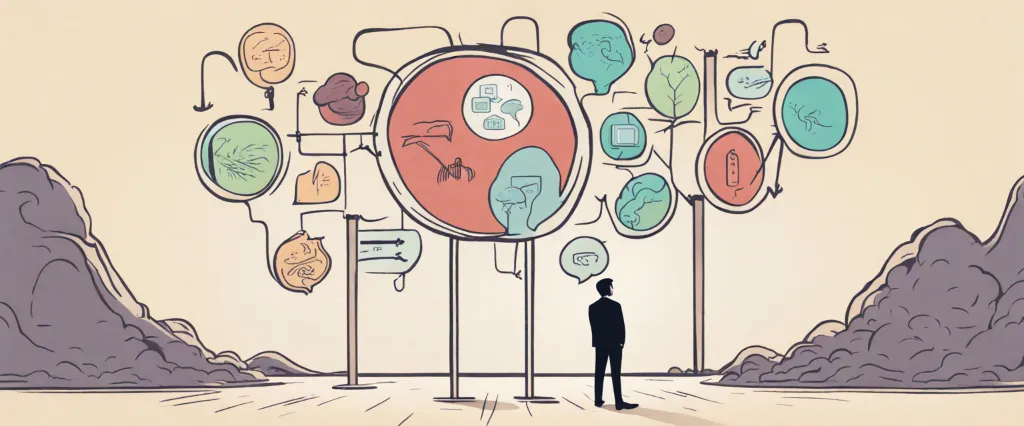In “The Happiness Hypothesis,” Jonathan Haidt explores the age-old quest for happiness, drawing insights from diverse fields such as psychology, philosophy, and Eastern spirituality. Through his thought-provoking analysis, Haidt strives to unravel the complexities of joy and contentment, offering readers a comprehensive understanding of what truly drives human happiness. As a renowned social psychologist and professor of ethical leadership, Haidt combines his academic expertise with a deep passion for understanding human nature, making him a highly respected authority in the field of positive psychology.
Chapter 1: The Divided Self – Exploring internal conflicts within human nature.
Chapter 1 of “The Happiness Hypothesis” by Jonathan Haidt, titled “The Divided Self – Exploring internal conflicts within human nature,” delves into the idea that humans are torn between their rational and emotional natures, leading to internal conflicts that affect their overall happiness.
Haidt begins by introducing the concept of the “rider and the elephant.” He explains that the rider represents reason and the conscious mind, while the elephant symbolizes emotions and the unconscious mind. He argues that the rider, although it believes itself to be in control, is often guided by the much more powerful elephant. This struggle within ourselves creates an internal division and contributes to our dissatisfaction and search for happiness.
The author then explores how our minds are divided in other ways, such as through the “modular mind” and the different roles played by different modules or systems in our brains. These modules, responsible for emotions, reasoning, and social interaction, may not always work in harmony, leading to further internal conflicts within us.
Haidt discusses the battle between intuition and reason – showing how sometimes our gut feelings or intuitions can be more accurate than our conscious reasoning. He highlights studies and experiments that demonstrate how our intuitive judgments often drive our moral decisions, even though our rational mind may try to justify these judgments afterward.
In summary, Chapter 1 of “The Happiness Hypothesis” examines the internal conflicts that arise between our rational and emotional selves, as well as the battle between intuition and reason. It emphasizes that understanding the complexities of these internal divisions is crucial for achieving happiness and personal fulfillment.
Chapter 2: Changing Your Mind – Examining the role of reason and emotion in belief transformation.
Chapter 2 of “The Happiness Hypothesis” by Jonathan Haidt, titled “Changing Your Mind – Examining the role of reason and emotion in belief transformation,” delves into the intricate relationship between reason and emotion when it comes to altering our beliefs. Haidt explores how our rational thinking and emotional responses interact, both supporting and hindering belief transformation.
The chapter begins by highlighting how conventional wisdom assumes that changing one’s mind requires presenting compelling reasons and evidence. However, Haidt argues that emotions play a crucial role in shaping our beliefs and often take the lead over reason. Our beliefs are not purely rational but influenced by our emotions, intuitions, and social environment.
Haidt introduces the concept of the Elephant and Rider metaphor, where the Elephant represents our emotional and intuitive side while the Rider symbolizes our rational thinking. He explains that although the Elephant may seem to overpower the Rider, they can work together effectively when aligned.
Furthermore, Haidt discusses motivated reasoning, a process where our emotions drive our reasoning to support our pre-existing beliefs. He examines experiments supporting the notion that emotions often guide our reasoning, reinforcing our convictions rather than challenging them. Haidt emphasizes how emotions can cloud our judgment, rendering reason ineffective in altering our beliefs.
He also introduces confirmation bias, the tendency to seek out information that supports our current beliefs while dismissing or discounting conflicting evidence. This bias further limits the potential for belief transformation.
In conclusion, Haidt suggests that changing one’s mind requires both appealing to reason and addressing the emotional and intuitive aspects of our beliefs. By understanding the complex interplay between reason and emotion, individuals can navigate the obstacles to belief transformation and find a balanced approach that considers both aspects of human cognition.
Chapter 3: Pursuit of Happiness – Investigating different theories and sources of happiness.
Chapter 3 of “The Happiness Hypothesis” by Jonathan Haidt, titled “Pursuit of Happiness – Investigating different theories and sources of happiness,” delves into various philosophical and psychological perspectives on happiness. Haidt seeks to answer the fundamental question of what makes people happy and explores two major theories: the hedonic theory and the eudaimonic theory.
The hedonic theory proposes that happiness is derived from the pursuit of pleasure and the avoidance of pain. Haidt acknowledges the importance of positive experiences and the role they play in happiness, but warns against excessive reliance on hedonic pleasures, as they tend to diminish over time and can even lead to unhappiness.
Contrasting with the hedonic theory, the eudaimonic theory suggests that happiness and well-being are achieved through living a meaningful and purposeful life. Haidt discusses the works of various philosophers, such as Aristotle and the Stoics, who stressed the importance of virtue, self-discipline, and striving for something beyond oneself as sources of enduring happiness.
The chapter also explores psychological research conducted on happiness. Haidt emphasizes the significance of positive relationships, as they are consistently associated with higher levels of happiness. He also discusses the concept of flow, a state of complete absorption and engagement in an activity, which contributes greatly to happiness and personal growth.
Furthermore, Haidt examines the role of genetics and external circumstances in determining happiness levels. He presents the concept of the “hedonic treadmill,” where individuals adapt to new circumstances and eventually return to their baseline level of happiness. However, he notes that while genetics and external factors can influence happiness to some degree, individuals still possess the capacity to cultivate and enhance their own happiness through intentional actions and mindset shifts.
In summary, Chapter 3 of “The Happiness Hypothesis” examines different theories and sources of happiness, highlighting the limitations of solely pursuing hedonic pleasures while encouraging a deeper exploration of personal meaning and purpose. The chapter also emphasizes the importance of positive relationships, engagement in fulfilling activities, and individual agency in attaining true and sustainable happiness.
Chapter 4: Faults of the Flesh – Discussing limitations of perception and the impact of physical well-being on happiness.

Chapter 4 of “The Happiness Hypothesis” by Jonathan Haidt, titled “Faults of the Flesh,” explores the limitations of human perception and the influence of physical well-being on happiness. Haidt highlights the idea that our minds are shaped by our bodies and the ways in which physical health impacts our mental well-being.
Haidt begins by discussing the concept of “affective forecasting,” which refers to our ability to predict our future emotions. He explains that humans tend to overestimate the intensity and duration of emotional states in response to both positive and negative events. This faulty perception impacts our pursuit of happiness, as we often make decisions based on inaccurate predictions of how certain outcomes will make us feel.
Additionally, Haidt emphasizes the impact of physical well-being on happiness. He examines various studies showing the strong correlation between good health and positive emotions. Physical exercise, adequate sleep, and a balanced diet have been found to contribute significantly to overall happiness levels. Conversely, health issues, chronic pain, or illness can diminish happiness.
Furthermore, Haidt addresses the aspect of beauty and its societal impact. Humans have a tendency to judge others based on their physical appearance, despite being aware of the irrationality of this behavior. Our perception of attractiveness can have profound societal and personal consequences, influencing our social interactions and sense of self-worth.
In this chapter, Haidt highlights the limitations of human perception and the inextricable link between physical well-being and happiness. It serves as a reminder that our perceptions and decisions may be flawed due to these limitations, and that taking care of our physical health is crucial for cultivating happiness in our lives.
Chapter 5: Pursuit of Pleasure – Analyzing the relationship between pleasure, desire, and happiness.
In Chapter 5 of “The Happiness Hypothesis,” titled “Pursuit of Pleasure – Analyzing the relationship between pleasure, desire, and happiness,” Jonathan Haidt explores the complex relationship between pleasure, desire, and happiness. Haidt begins by discussing the powerful role that pleasure plays in our lives, describing it as a basic human drive similar to hunger or thirst. However, he points out that pleasure alone does not necessarily lead to happiness in the long term.
Haidt introduces the theory of “hedonic adaptation,” which suggests that humans have a tendency to quickly adapt to pleasurable experiences. This concept explains why initially exciting activities or possessions tend to lose their novelty and no longer provide the same level of happiness or pleasure over time. He argues that constantly seeking new sources of pleasure often leads to a never-ending cycle of desire and dissatisfaction.
Using psychological research and ancient wisdom, Haidt proposes an alternative approach to happiness. Instead of striving for momentary pleasures, he suggests that true happiness can be found by cultivating activities and relationships that provide a sense of meaningful engagement. By focusing on activities that align with our values and goals, we can experience a deeper, more sustainable form of happiness.
Haidt explores the idea of “flow,” a state of optimal experience in which one is fully engaged, focused, and fulfilled in the present moment. He explains that flow can be achieved by participating in activities that challenge our skills but also provide a sense of purpose and personal growth. Additionally, he emphasizes the importance of cultivating social connections and being part of a larger community to enhance overall well-being.
In essence, Chapter 5 highlights the limitations of relying solely on pleasure for happiness and encourages readers to seek fulfillment through meaningful engagement and connections with others.
Chapter 6: Uses of Adversity – Examining the role of challenges in personal growth and resilience.
Chapter 6 of “The Happiness Hypothesis” by Jonathan Haidt explores the uses of adversity and examines the role of challenges in personal growth and resilience. Haidt begins by discussing the common belief that adversity is detrimental to happiness and well-being, but he challenges this perspective by presenting research that suggests adversity can actually have positive effects on individuals.
The chapter delves into the concept of post-traumatic growth, wherein individuals who have experienced significant adversity report higher levels of personal growth and life satisfaction than those who have not faced such challenges. Haidt highlights that adversity can act as a catalyst for personal development, leading individuals to reassess their values, priorities, and goals. By facing adversity, people can develop greater compassion, empathy, and a deeper understanding of themselves and others.
Haidt also explores the idea of “adversarial growth,” emphasizing that challenges can strengthen an individual’s resilience. Much like physical exercise that tears down muscle fibers to rebuild them stronger, facing and overcoming adversity can enhance an individual’s psychological resilience and ability to cope with future challenges. Adversity pushes people out of their comfort zones and forces them to develop strategies to overcome obstacles, leading to personal growth and heightened resilience.
Finally, the chapter discusses the role of meaning-making in navigating adversity. Haidt posits that finding meaning in difficult experiences can provide individuals with a sense of purpose and help them make sense of their suffering. This meaning-making process can offer comfort and a sense of control over otherwise uncontrollable circumstances.
In summary, this chapter explores the positive effects of adversity on personal growth and resilience. Adversity can serve as a catalyst for growth, leading individuals to develop greater empathy, compassion, and self-understanding. Additionally, overcoming challenges promotes psychological resilience and equips individuals with skills to better cope with future hardships. The ability to find meaning in adversity also provides a sense of purpose, comfort, and control in the face of difficult circumstances.
Chapter 7: Meaningful Life – Exploring the importance of finding meaning and purpose in life.
In Chapter 7 of “The Happiness Hypothesis” by Jonathan Haidt, the author delves into the significance of finding meaning and purpose in life. Haidt argues that the pursuit of happiness alone is insufficient for a truly fulfilling life; we must also explore deeper questions about the meaning of our existence and our purpose in the world.
Haidt begins by examining various philosophical and psychological perspectives on the importance of meaning. He highlights Viktor Frankl’s famous book “Man’s Search for Meaning,” in which Frankl emphasizes the role of finding purpose in the face of adversity and suffering. Haidt also draws from research on happiness that suggests individuals who have a strong sense of purpose tend to be happier and exhibit greater resilience in the face of challenges.
Furthermore, Haidt explores the concept of the “divided self,” where individuals often have conflicting desires and motivations. He posits that pursuing a meaningful life can help unite these conflicting aspects of our selves, creating a sense of coherence and internal harmony.
The author introduces the idea of “hive psychology,” which suggests that people have an inherent desire to be a part of something greater than themselves. Engaging in pro-social activities that benefit others and contribute to the collective well-being can provide a profound sense of meaning.
Haidt also discusses the importance of self-transcendence and offers insights from spiritual and religious traditions. These traditions often emphasize the need to look beyond oneself and cultivate a sense of connection to others or a higher power, fostering a sense of purpose and meaning.
In conclusion, Haidt explores the importance of finding meaning and purpose in life, arguing that it goes hand in hand with the pursuit of happiness. By seeking deeper connections, engaging in pro-social activities, and transcending the self, individuals can experience a more meaningful and fulfilling existence.

Chapter 8: Divided Society – Investigating the impact of social relationships and cultural values on happiness.
Chapter 8 of “The Happiness Hypothesis” by Jonathan Haidt delves into the impact of social relationships and cultural values on happiness. Haidt begins by highlighting the paradox of happiness in modern society; although people today have higher living standards and more individual freedoms than ever before, rates of depression and anxiety are also on the rise. He suggests that understanding the impact of social relationships and cultural values is crucial for promoting happiness.
Haidt introduces the concept of “vertical and horizontal societies” to explain the differences between individualistic and collectivist cultures. Vertical societies prioritize hierarchy and social order, valuing loyalty and respect for authority. In contrast, horizontal societies emphasize equality and mutual support, valuing fairness and personal freedom. Haidt argues that individuals tend to be happier in societies that align with their personal values and social relationships.
The author examines the psychological mechanisms that influence happiness in social relationships. He explores the importance of trust, reciprocity, and strong social connections in fostering happiness. Haidt also highlights the role of rituals and communal experiences in strengthening social bonds and promoting a sense of belonging.
Furthermore, Haidt discusses the influence of cultural values on happiness. He explains that the values promoted in a particular culture impact individuals’ beliefs and behaviors, ultimately affecting their well-being. He compares the cultural values of individualism and collectivism, emphasizing the importance of finding a balance between personal desires and communal responsibilities.
In summary, Chapter 8 of “The Happiness Hypothesis” highlights the significant impact of social relationships and cultural values on happiness. Haidt demonstrates that understanding and nurturing these aspects can play a crucial role in promoting personal well-being and societal happiness.
After Reading
In conclusion, Jonathan Haidt’s “The Happiness Hypothesis” offers a thought-provoking exploration of the human pursuit of happiness. By delving into ancient wisdom and modern science, Haidt presents a compelling thesis that happiness is not solely determined by external circumstances but is also influenced by our own psychological makeup. By examining fundamental concepts such as virtue, love, and spirituality, the author provides valuable insights into the various factors that contribute to human well-being. Through engaging storytelling and rigorous research, Haidt encourages readers to question their assumptions and consider the complex interplay between genetics, culture, and personal choices in the quest for a fulfilling life. Ultimately, “The Happiness Hypothesis” serves as a guide to understanding the multifaceted nature of happiness and offers practical tools to navigate its pursuit in the modern world.
1. The Power of Now: A Guide to Spiritual Enlightenment” by Eckhart Tolle – This book explores the concept of living in the present moment and finding happiness by letting go of past regrets and future anxieties. It delves into the importance of self-awareness and living with acceptance.
2. Mindsight: The New Science of Personal Transformation” by Daniel J. Siegel – In this book, Daniel Siegel explores the power of the mind and how developing a deeper understanding of our thoughts, emotions, and experiences can lead to personal transformation and enhanced well-being.
3. “Stumbling on Happiness” by Daniel Gilbert – Daniel Gilbert’s work delves into the mysteries of human happiness, highlighting the various mistakes our minds make when trying to predict what will make us happy. It provides insights into our misconceptions about happiness and offers practical approaches to finding true fulfillment.
4. Flow: The Psychology of Optimal Experience” by Mihaly Csikszentmihalyi – This book delves into the concept of “flow,” a state of complete immersion and focus on an activity that leads to happiness and peak performance. Mihaly Csikszentmihalyi explores the conditions necessary to achieve this state and how it can be applied to various aspects of life.
5. Man’s Search for Meaning” by Viktor E. Frankl – This poignant memoir by renowned psychiatrist Viktor Frankl depicts his experiences during the Holocaust and how he found meaning and purpose even in the darkest of circumstances. It offers powerful insights into the human capacity for resilience, meaning-making, and the pursuit of happiness.




